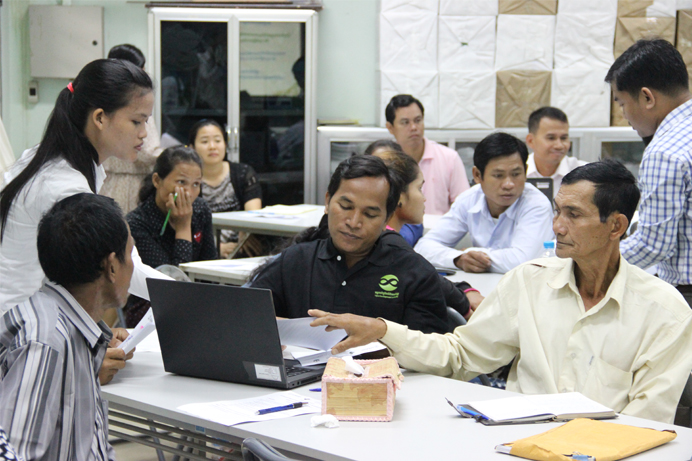
Phnom Penh, August 25-27, 2015: In responding to the NGOs and communities need to improve working quality, the NGO Forum on Cambodia (NGOF) organized a three-day training workshop on “Environmental Impact Assessment (EIA) Monitory and Effective Communications”. The objectives of this training were to strengthen capacity of CSOs/NGOs network members and communities to understand the general concept of EIA and EIA process, particularly to gain knowledge on how to monitor the Environmental Management Plan (EMP), which was stated in the EIA report of the development projects in Cambodia, and how to use Information and Communications Technology (ICT) tools to bring more effective work.
Twenty eight participants (12 females) that attended this session were from the NGOF four projects’ network members, including the Rivers Coalition in Cambodia (RCC), NGOs Environment & CC Alliance (NECA), CSOs REDD+, Network for Development of Food Security & Safety in Cambodia (NDF-C), and communities who will be/were affected by development projects in Cambodia.
“The first two days of our training began with the EIA process that we have invited trainers from the Ministry of Environment to give the lecture, since they are the one that really know clearly about the concept and work directly with this issue,” Ms. Chea Phallika, Community Rights on Hydropower Development Project Coordinator of NGOF shared. Phallika also added that on the third training day, the class focus on on the ICT training, in which the agenda was created based on the actual need for the NGOs workers and Communities. For the whole day, the group was lectured on professional ICT and method of writing various important subjects including, how to write hot news, how to use smart phones to take photos and video, and lastly, the safe phone application for the group communications. “I was very glad, myself, to attend this training since, I have learned a lot about the technology knowledge that I never ever know before,” she added.
The Environmental Impact Assessment (EIA) process is a multistep procedure to ensure that environmental considerations are included in decisions regarding projects that may impact the environment. The purpose of the EIA process is to inform decision-makers and to promote transparency and public involvement of the environmental consequences by a proposed project implementation.
The EIA document identifies, predicts, and analyzes impacts on the physical environment, as well as social, cultural, and health impacts. Stage of the EIA process generally consists of a set of procedural steps, including i) Identifying and Defining the Project or Activity; ii) Screening; iii) Scoping; iv) Preparing Terms of Reference; v) Preparing Draft EIA; vi) Public Participation; vii) Preparing Final EIA; viii) Decision; ix) Administrative or Judicial Review; x) Project Implementation; xi) Monitoring.
Mr. Srey Ly Ber, the community member from the Kbal Romeas District, Steung Treng province mentioned that this course was a very significant once for the participants, especially, the communities because they are able to understand better about the EIA issue, and he could bring back the knowledge he learned to share with his community to gain knowledge and more result of their advocacy work with the development project, in which going to affect their lives in short future. “I am also very happy that NGOF provide the technology course to us. I am very curious in every subject that we have learned today because each of them provides us different benefits such as how to write short news that will help us to share the information from the community to NGOs or media. Specifically, I do enjoy learning about the Facebook and how to use it to promote our advocacy work.”
Base on the pre and post-test with the participants, it was addressed the increase by half of its basic knowledge provided by trainers within EIA sessions. However, trainees raised that even they understood about the EIA monitoring, but they didn’t know what kind of official documents that they could use to monitor the project for example the EMP which written in the EIA report. Respectively, the ICT was caught most interest among learners and as a result, trainees could develop a Telegram Group named “RCCNGOF” to sharing news and information related to the monitoring development project activities in their target areas.
“This training is absolutely essential and help in term of working quality and effectiveness. For example, with social media network like Facebook, I can transfer the information quickly about affected communities as soon as the incident occurs to media and the public. As you know, the reporters are not always very close the affective communities, and we always have such trouble in sharing the news to them,” said Ms. Nhuy Nang Noy, 3SPN staff.
